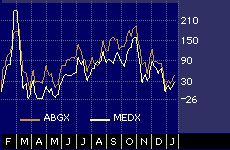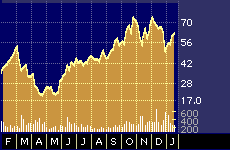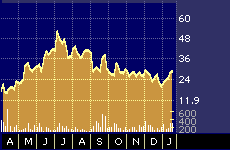
New Index May Move Biotechs
New Index May Move Biotechs
By Hal Plotkin
CNBC.com Silicon Valley Correspondent
Jan 25, 2001 05:39 PM

In the biotechnology arena, the Nasdaq Stock Market is taking on the American Stock Exchange, and, if you own some of these stocks, you might soon end up the winner.
On Monday, Nasdaq announced substantial changes in the components of its up-to-now mostly ignored Nasdaq Biotechnology index {IXBT}. The changes are designed to reconstitute Nasdaq’s branded biotech index so that it will better compete with the Amex’s already well-entrenched biotech index {.btk}.
Many large mutual funds give considerable weight to the Amex index as a screening tool, which they use to build a diversified portfolio of biotech stocks that they sell as a package to retail investors. Nasdaq’s newly honed biotech index will also be tradable beginning on Feb. 2 when a new Barclays Global Investors exchange traded fund, called the iShares Nasdaq Biotechnology Index fund, debuts.
In addition, Nasdaq officials promise that there will be a variety of other new financial products based on its new biotech index rolled out before too long.
“I think it’s positive news for biotechs and particularly for the stocks on the new list,” says Jim McCamant, the veteran biotech stock picker who publishes the Medical Technology Stock Letter, based in Berkeley, Calif.
The changes pared Nasdaq’s old index down from 202 companies to 76, the result of new inclusion criteria that eliminated the smaller-cap biotech stocks usually shunned by most institutional investors.
CNBC.com: See the Full List of the Stocks on Nasdaq’s new biotech index here
Luminex Corp. {LMNX} is the only firm that was added to Nasdaq’s list that didn’t appear on its previous index.
“We believe this revision may introduce volatility, as investors who weight their portfolios on the basis of the index move to realign their holdings,” says Andrew Milne, an analyst at Dain Rauscher Wessels in Minneapolis.
Like Milne, most observers who track the sector agree that the new index will have an impact that could grow over time, depending on the popularity of the new investment vehicles on which it is based.
But that is where the agreement ends.
Milne thinks the advantage will go to the companies on the list that have the strongest balance sheets. His favorite picks moving into the index change are Abgenix Inc. {ABGX}, IDEC Pharmaceuticals Corp. {IDPH} and Medarex Inc. {MEDX}, all three of which are on both the Amex and Nasdaq lists.

52-Week Stock-Performance Comparison of Abgenix and Medarex
Milne has “buy” ratings on Abgenix and IDEC, and a “strong buy” rating on Medarex, with 12-month price targets of 60, 85, and 75, respectively.
Abgenix and Medarex are losing money. But Milne points out that Abgenix has about $750 million in cash on hand, while Medarex still has about $360 million in the bank.
“Abgenix is in the position where they can almost fund their operating expenses out of interest income,” Milne says. “The cash puts Abgenix and Medarex in a very strong position.”
Meanwhile, now-profitable IDEC is benefiting from its lucrative drug-development partnership with Genentech Inc. {DNA} that led to the creation of Rituxin, a successful new compound that treats a form of non-Hodgkin’s lymphoma.
McCamant, on the other hand, thinks the clear advantage in the months immediately ahead will go to ImClone Systems Inc. {IMCL}, a stock he has been pounding the table on for months.

52-Week Stock-Performance of IDEC Pharmaceuticals

52-Week Stock-Performance of ImClone Systems

52-Week Stock-Performance of Luminex
McCamant says ImClone Systems is nearing regulatory approval to start selling a new anti-cancer drug, presently called C225, sometime later this year.
“I’d be favoring the drug-development companies that are bringing important new products to market this year,” McCamant says. “The market potential for ImClone’s new drug is five times larger than Rituxin, and you saw what Rituxin did for IDEC.”
McCamant says Abgenix and Medarex could also be good buys right now, given their rather sharp declines from their all-time highs. But he is worried that IDEC’s stock may still be ahead of itself.
“Abgenix and Medarex have come down enough so they could be fairly attractive short-term buys,” McCamant says. “But I’d stay away from IDEC, which is now significantly overvalued, in my opinion.”
Luminex is another stock that could get a lift when the new index-based fund starts trading next week. The company sells a new type of testing technology that greatly accelerates the drug-discovery process.
“Luminex was already one of my best picks for the year, so this is very good news,” says Anna Kazanchyan, an analyst at First Union Securities Inc. in New York.
Kazanchyan has a “buy” rating, her firm’s highest recommendation, on Luminex’s stock, along with a $50 12-month price target.
“Luminex is one of the few genomics companies to anticipate profits in 2002,” Kazanchyan says. “They have $77 million in the bank and are only burning about $10 million a year. They have a high likelihood of becoming a standard testing technology. Being on the new list will bring the company to the attention of more investors.”
One consequence of the new index, however, is the slighting of many smaller, less-well-known but still-promising biotech firms. Nasdaq’s new list excludes, for example, any stock priced under 10 a share as well as stocks that have an average daily trading volume of less than 100,000 shares.
“The smaller-cap stocks are where you often see the most risk but also sometimes the best rewards,” notes Alfred Mansour, Ph.D., the founder of BiotechWatch.com.
BiotechWatch.com tracks the progress of large and small biotech firms, including staying current on the drug-development efforts that might one day land at least some of the smaller firms on the major biotech stock indexes.
“We [saw] a flight to quality after what happened to the Internet stocks, and the new biotech index is along those same lines,” Mansour says. “But there are some very interesting things going on in the smaller-cap biotech stocks, too, so they’re worth looking at.”
Even without the new index, McCamant says that the biotech sector is worthy of attention right now, given how steeply many of the leading stocks sold off late last year. There had been some worries, going into the early part of this year, of even more selling over the short term, in conjunction with the expiration of lock-up periods on the more than a dozen biotech firms that went public during the second half of 2000.
But those fears have largely abated, McCamant says, given the recent decline in many of those stocks to near or even below their original offering prices.
“The stocks went down further at the end of the year than many had anticipated,” McCamant says. “But the new index should help because one of the problems was always ‘how do you invest in biotech?’ This is going to make that a little easier to figure out and probably will attract more money into biotech.”


